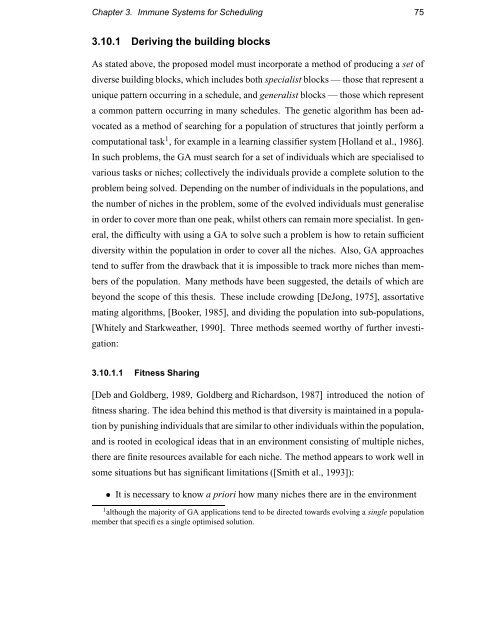Immunology as a Metaphor for Computational ... - Napier University
Immunology as a Metaphor for Computational ... - Napier University
Immunology as a Metaphor for Computational ... - Napier University
Create successful ePaper yourself
Turn your PDF publications into a flip-book with our unique Google optimized e-Paper software.
Chapter 3. Immune Systems <strong>for</strong> Scheduling 753.10.1 Deriving the building blocksAs stated above, the proposed model must incorporate a method of producing a set ofdiverse building blocks, which includes both specialist blocks — those that represent aunique pattern occurring in a schedule, and generalist blocks — those which representa common pattern occurring in many schedules. The genetic algorithm h<strong>as</strong> been advocated<strong>as</strong> a method of searching <strong>for</strong> a population of structures that jointly per<strong>for</strong>m acomputational t<strong>as</strong>k 1 , <strong>for</strong> example in a learning cl<strong>as</strong>sifier system [Holland et al., 1986].In such problems, the GA must search <strong>for</strong> a set of individuals which are specialised tovarious t<strong>as</strong>ks or niches; collectively the individuals provide a complete solution to theproblem being solved. Depending on the number of individuals in the populations, andthe number of niches in the problem, some of the evolved individuals must generalisein order to cover more than one peak, whilst others can remain more specialist. In general,the difficulty with using a GA to solve such a problem is how to retain sufficientdiversity within the population in order to cover all the niches. Also, GA approachestend to suffer from the drawback that it is impossible to track more niches than membersof the population. Many methods have been suggested, the details of which arebeyond the scope of this thesis. These include crowding [DeJong, 1975], <strong>as</strong>sortativemating algorithms, [Booker, 1985], and dividing the population into sub-populations,[Whitely and Starkweather, 1990]. Three methods seemed worthy of further investigation:3.10.1.1 Fitness Sharing[Deb and Goldberg, 1989, Goldberg and Richardson, 1987] introduced the notion offitness sharing. The idea behind this method is that diversity is maintained in a populationby punishing individuals that are similar to other individuals within the population,and is rooted in ecological ide<strong>as</strong> that in an environment consisting of multiple niches,there are finite resources available <strong>for</strong> each niche. The method appears to work well insome situations but h<strong>as</strong> significant limitations ([Smith et al., 1993]):¢ It is necessary to know a priori how many niches there are in the environment1 although the majority of GA applications tend to be directed towards evolving a single populationmember that specifies a single optimised solution.









![Unit 5. Switches and VLANs [PDF]](https://img.yumpu.com/34422504/1/184x260/unit-5-switches-and-vlans-pdf.jpg?quality=85)






